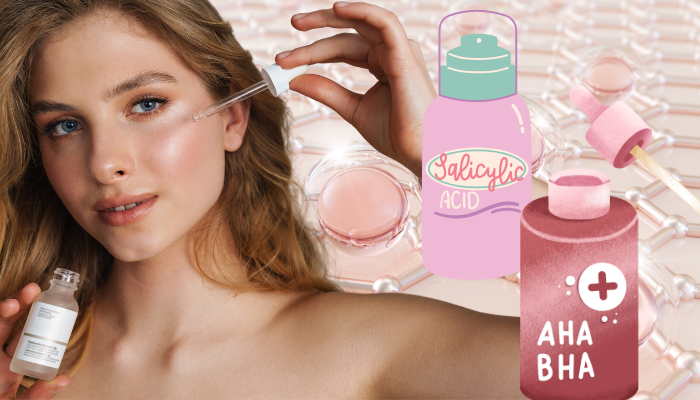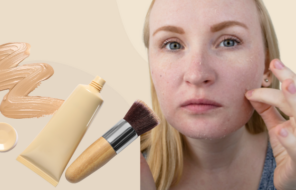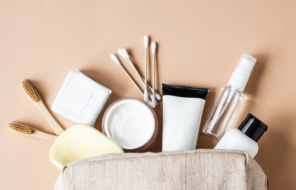We know what you’re thinking. Salicylic acid, what’s that? Sounds complicated, maybe even dangerous. I’ll pass. Stop right there, girlfriend. Let’s rewind and start from the beginning.
Salicylic acid, otherwise referred to as beta hydroxy acid (BHA), is an important, naturally occurring compound that can improve skin tone, remedy acne-prone skin, and reduce excess oil. Intrigued? I thought so.
This article will provide you with a thorough explanation of what salicylic acid is and how it works. Our goal is to equip you with the relevant knowledge on salicylic acid for skin and send you on your way more informed than the next girl.
What is salicylic acid/BHA?
Salicylic acid is an acid (shocker) derived from salicin, a naturally occurring compound that is found in the bark of willow and aspen trees. It is closely related to acetylsalicylic acid, which is more commonly known as aspirin. Commercial salicylic acid is generally created in a lab by exposing sodium phenolate to carbon dioxide in a high temperature environment.
Salicylic acid has both anti-inflammatory and antibacterial properties. It is a beta hydroxy acid, which means that the hydroxy molecule is separated from the acid compound by two carbon atoms. Compare this with alpha hydroxy acids (like glycolic acid), which are separated by one carbon atom.
BHA is a gentle acid and is a popular ingredient in skincare products, specifically ones marketed to remedy acne. Because of its pore-penetrating properties and its role in sloughing away dead skin cells, salicylic acid is a useful remedy for a range of maladies, from eczema to dryness to breakouts.
Fun fact: salicylic acid is not merely found in trees. It can be found in strawberries, blackberries, and kiwis!
How does salicylic acid work?
Salicylic acid works to improve the skin in two ways: it exfoliates the skin surface and reduces inflammation. Unlike glycolic acid, salicylic acid is oil soluble, making it well suited to exfoliate oily skin. Because it is oil soluble, it penetrates into the pores rather than remaining on the surface.
As skin care expert Paula Begoun often says, salicylic acid exfoliates within the pore, unclogging it of sebum and bacteria and preventing breakouts. Contrast this with glycolic acid, which exfoliates the surface of the skin. By exfoliating, what we mean to say is that salicylic acid breaks down the glue that holds together dead skin cells, releasing them and allowing them to shed. This ‘glue’ we refer to is a protein known as keratin.
Because of these powerful properties, salicylic acid is known as a keratolytic agent, a normalizer of the skin shedding (keratinization) process. Chemical exfoliation is a necessary process, which improves the texture and function of the skin. Consider the process to be like spring-cleaning: out with the old, in with the new.
The second way salicylic acid functions to improve the skin is by reducing inflammation. Because its molecules are larger, it is less likely to burden and irritate the skin. Contrast this with glycolic acid, whose smaller molecules can increase localized redness and discomfort on the skin surface.
Salicylic acid, much like its relative aspirin, works to rapidly counter inflammation caused by breakouts. It reduces the size and redness of painful breakouts and helps to soothe the skin. This anti-inflammatory effect also makes it a wonderful and gentle exfoliant for women with sensitive skin or conditions like rosacea.
Pros & Cons of Salicylic Acid for Skin
Like all entities, salicylic acid isn’t all sugar and spice and everything nice. To provide you with a more balanced understanding of the compound, let’s provide a cursory examination of its sweet and not so sweet sides.
Salicylic Acid Benefits:
- It exfoliates the skin, aiding in the removal of dead and dull skin cells.
- In tandem with removing the outer layer of the skin, BHA reveals brighter and more vibrant skin.
- It unclogs pores and eliminates whiteheads and blackheads.
- Pores become larger when they are loaded up with dirt, dead skin, and oils and by removing these impurities salicylic acid works to minimize the appearance of pores.
- BHA speeds up the healing process of acne and blemishes.
- It improves uneven skin texture by sloughing away the cells that reduce skin clarity.
- Salicylic acid soothes skin affected by redness and irritation.
- It is appropriate and suitable for all skin types.
- BHA is gentle enough for sensitive skin profiles and for frequent use.
- It doesn’t make the skin photosensitive (i.e. more prone to sun damage) like many other chemical exfoliants.
- Sustained use can prevent breakouts from forming in the first place, further evidence that it should be incorporated into your general skincare routine on a more consistent basis.
- Salicylic acid products reduce pigmentation because it inhibits melanin formation. This makes salicylic acid a sound choice for reducing sunspots, age spots, and hyperpigmentation.
Salicylic Acid Side Effects:
Compared to all the benefits, the drawbacks to using BHA products are quite minor:
- Salicylic acid is often incorporated into harsh formulas and toners so it is vital to research the products you are using. If you are prone to sensitive skin, ensure that your BHA infused product is specifically designed to be gentle and non-abrasive.
- It can trigger a process called skin purging. Purging refers to the kind of breakout that occurs after using an active ingredient. It typically appears one to two weeks after beginning use of the active. This process occurs because salicylic acid is rapidly removing surface layer skin cells and breakouts and oils that were underneath this layer are now exposed, and potentially irritated.
- It is possible to over exfoliate the skin with any exfoliating product, so pay attention to your skin for signs of over exfoliation like irritation, dryness, tightness, or flakiness.
- Pay attention to the other active ingredients in your routine. Salicylic acid plays nicely with nearly all skincare ingredients, but some women’s skin can’t handle too many active skin compounds in their routine.
- Women with extremely dry skin profiles may experience irritation and discomfort upon application of BHA products. If this describes you, it may be more appropriate to use the product once every couple of weeks.

Salicylic Acid Cautions
- Women with aspirin allergies should absolutely avoid using any product that contains salicylic acid.
- There are mixed reviews on whether salicylic acid is safe for pregnant women to use topically. We would recommend consulting a dermatologist beforehand.
- Salicylic acid products are not recommended if you are using blood thinners.
How do you use salicylic acid?
Salicylic acid is a dynamic little shapeshifter and can be found in a range of formulas, including cleansers, toners, serums, and moisturizers. It is also a salient ingredient in acid peels.
Salicylic acid is most effective when it has time to absorb into the skin (think 20+ minutes), so BHA cleansers are a less effective mode of application. To get the most out of salicylic acid in your skincare routine, be cognizant of the application tips below.
- Cleanse
Begin by cleansing your skin with a gentle, low-pH cleanser, like this CosRX cleanser. Ensure that you rinse the skin completely after applying your cleanser.
- Tone
For oilier skin profiles, use a gentle pH-adjusting toner to reduce excess oil and dirt.
- Apply Vitamin C
If you use a product with vitamin C as an active ingredient, it is best to use it before salicylic acid, and to wait 20 minutes before applying.
- Apply Your BHA
Apply your salicylic acid product. If it’s a gel or lotion, apply a pea-sized amount, and massage into skin in upward motions. If your salicylic acid is in the form of a liquid or toner, you can choose to apply it with a cotton pad, or by carefully dispensing it into your palms and dabbing it onto the face. Some of our favorite salicylic acid products come in a pre-soaked pad formula, which is foolproof to use.
- Give It Some Time
Wait 15-30 minutes before applying any other products. This allows the salicylic acid to exfoliate the skin and provides enough time for the skin’s pH to readjust. You don’t need to wash the salicylic acid off, as it will have absorbed into your pores and will be providing your skin with all day benefits.
- Finish off Your Skincare
Follow it up with the rest of your skincare routine. Apply your products in this order: other actives like glycolic acid, hydrating essences and serums, lotions and moisturizers. Top it off with a face sunscreen in the daytime and/ or an occlusive cream in the evening.
One additional note on peels: often peel products will include salicylic acid combined with other active acids. Because of the potency of these ingredients, we do strongly recommend cleansing your skin thoroughly (you might even have to neutralize it with a neutralizing solution) before continuing with the other steps in your skincare routine. Always read the directions on the package before using a product.
How often can you use BHA products?
Salicylic acid is considered an “active ingredient”, which means that it has a potent impact on the texture and quality of the skin. Such benefits rarely come without a few disclaimers, however. Because of its power, salicylic acid also has the potential to irritate the skin. It is key to incorporate it into your skincare routine carefully and patiently.

When you begin your journey with salicylic acid, it is important to use it 2 to 3 times a week at most. Apply and give your skin a day or two off to see how you interact with the product. Monitor how you feel and whether there are any increases in irritation, itching, or redness.
This is a wonderful way of understanding how your skin reacts to salicylic acid products and can provide you with an understanding of how often it should be used. Each skin profile is unique and some women will find that they can use the product daily, while others feel more comfortable saving it for an occasional treat.
If you find that your skin reacts well, you can certainly use salicylic acid products daily. We recommend using it once a day. Evenings are preferable because your skin can absorb all of the salicylic acid benefits uninterrupted while you sleep.
How do you choose an effective salicylic acid product?
We’ll let you in on a secret about salicylic acid. It can be a high-maintenance product to choose. The pH formula of your chosen formula is vital. We can’t stress this enough. For effective, and gentle exfoliation, the pH of the formula should be between 3 and 4. If the pH is lower, it will be irritating and harsh. Any formula over 4 will lack the exfoliating prowess that salicylic acid has to offer.
There are studies that claim regular use of a salicylic acid formula containing a higher level of pH imparts benefits to the skin. These studies are not fully conclusive, so why risk spending money on a product that will be less effective than the top performers?
Salicylic acid is extremely effective in formulas that boast a percentage between 1% and 2%. You will notice that most popular blends contain 2%, but 1% is the golden quantity for women with more sensitive skin.
Salicylic acid is most effective when given the space and time to fully absorb into the skin. It is best used in the form of a toner, liquid, serum, lotion, or essence. It is best applied after the cleansing stage and before the moisturizing stage.
Cleansers containing salicylic acid are not as effective as the latter options, as the true power of the acid is unleashed upon absorption.





